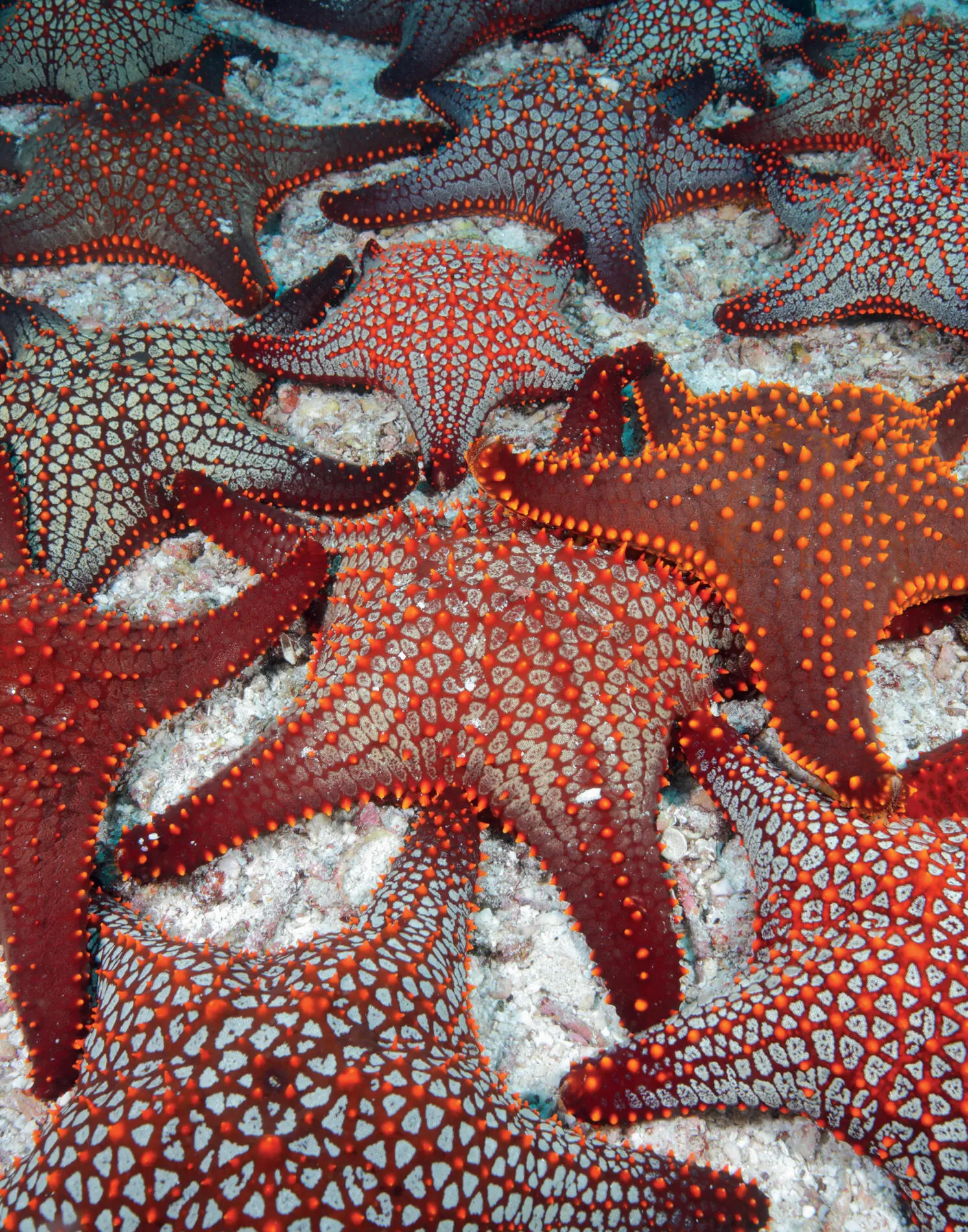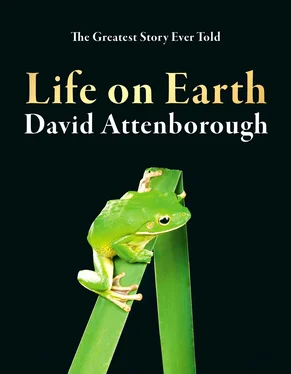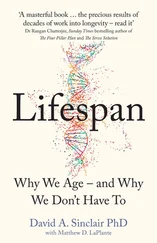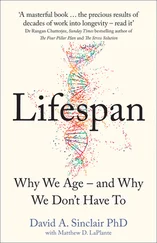1 ...8 9 10 12 13 14 ...20 But what of the second great category of animals without backbones, the one represented in ancient rocks by the flower-like crinoids? As these are traced upwards through the rocks, they become more elaborate and their fundamental structure becomes clearer. Each has a central body, the calyx, rising from a stem like the seedhead of a poppy. From this sprout five arms which, in some species, branch repeatedly. The surface of the calyx is made up of closely fitting plates of calcium carbonate, as are the stems and branches. Lying in the rocks, the stems look like broken necklaces, their individual beads sometimes scattered, sometimes still in loose snaking columns, as though their thread had only just snapped. Occasionally gigantic specimens are found with stems 20 metres long. These creatures, like the ammonites, have had their day, but a few species, sometimes called sea lilies, still survive in the ocean depths.

Bigfin squid ( Sepioteuthis lessoniana ) hovering in open water above a coral reef at night. Dampier Strait, Raja Ampat, West Papua, Indonesia. Tropical West Pacific Ocean.

Crinoid (feather star, centre) on a gorgonian (sea fan, red) with a Dendronephthya soft coral in the background, Andaman Sea, Thailand.
Sea lilies show that the calcium carbonate plates, in life, are embedded just under the skin. This gives their surface a curious prickly feel. In other families, related to the crinoids, the skin has spines and needles attached to it so the creatures are known as echinoderms, ‘spiny-skins’. The basic module on which the echinoderm body is built has a fivefold symmetry. The plates on the calyx are pentagons. Five arms extend from it, and all the internal organs occur in groups of five. Their bodies work by a unique exploitation of hydrostatic principles. Tube feet, each a thin tube ending in a sucker and kept firm by the pressure of water within, wave and curl in rows along the arms. The water for this system circulates quite separately from that in the body cavity. It is drawn through a pore into a channel surrounding the mouth and circulated throughout the body and into the myriads of tube feet. When a drifting particle of food touches an arm, tube feet fasten on to it and pass it on from one to another until it reaches the gutter that runs down the upper surface of the arm to the mouth at the centre.

Tube feet of a red cushion sea star ( Oreaster reticulatus ), Singer Island, Florida.
Though stalked sea lilies were the most abundant crinoid in fossil times, the commonest forms today are the feather stars. Instead of stalks, they have a cluster of curling roots with which they attach themselves to coral or rocks. In places on the Great Barrier Reef, they swarm in huge numbers, covering the floor of the tidal pools with a tufted coarse carpet of brown. When disturbed, however, they can suddenly swim away, writhing their five limbs like Catherine wheels.
The fivefold symmetry and the hydrostatically operated tube feet are such distinctive characteristics that they make other echinoderms very easy to recognise. The starfish and their more sprightly cousins, the brittle stars, both possess them. These creatures appear to be crinoids that have neither stalk nor rootlets and are lying in an inverted position with their mouths on the ground and their five arms outstretched. Sea urchins too are obviously related. They seem to have curled their arms up from the mouth as five ribs and then connected them by more plates to form a sphere.
The sausage-like sea cucumbers that sprawl on sandy patches in the reef are also echinoderms, although in most species their shelly internal skeletons are reduced to tiny structures beneath the skin. Most lie neither face up nor face down, but on their sides. At one end there is an opening called the anus, though the term is not completely appropriate for the animal uses it not only for excretion but also for breathing, sucking water gently in and out over tubules just inside the body. The mouth, placed at the other end, is surrounded by tube feet that have become enlarged into short tentacles. These fumble about in the sand or mud. Particles adhere to them and the sea cucumber slowly curls them back into its mouth and sucks them clean with its fleshy lips.
One highly specialised deep-sea sea cucumber, called a sea-pig, lives in the mud of the deep seabed at depths of up to 5,000 metres. They are rotund little creatures about 15 centimetres long and have large tube-like structures on their underside with which they rootle about in the mud. They have been filmed in the deep sea, assembled in herds, perhaps for reproduction or attracted by the smell of a new source of food drifting down from the surface.
If you pick up a sea cucumber, do so with care, for they have an extravagant way of defending themselves. They simply extrude their internal organs. A slow but unstoppable flood of sticky tubules pours out of the anus, fastening your fingers together in an adhesive tangle of threads. When an inquisitive fish or crab provokes them to such action, it finds itself struggling in a mesh of filaments while the sea cucumber slowly inches itself away on the tube feet that protrude from its underside. Over the next few weeks it will slowly grow itself a new set of entrails.
The echinoderms may seem, from a human point of view, to be a blind alley of no particular importance. Were we to imagine that life was purposive, that everything was part of a planned progression due to culminate in the appearance of the human species or some other creature that might rival us in dominating the world, then the echinoderms could be dismissed as of no consequence. But such trends are clearer in the minds of people than they are in the rocks. The echinoderms appeared early in the history of life. Their hydrostatic mechanisms proved a serviceable and effective basis for building a variety of bodies, but were not susceptible in the end to spectacular development. In the areas that suit them, they are still highly successful. A starfish on the reef can crawl across a clam, fasten its tube feet on either side of its gape and slowly wrench the valves apart to feed on the flesh within. The crown-of-thorns starfish occasionally proliferates to plague proportions and devastates great areas of coral. Crinoids are brought up in trawls from the deep sea several thousand at a time. If it is improbable that any further major developments will come from this stock, it is also unlikely, on the evidence of the last 600 million years, that the group will disappear as long as life remains possible at all in the seas of the world.

Panamic cushion sea stars ( Pentaceraster cumingi ) group on seafloor, Galapagos Islands.
The third category of creatures on the reef contains those with segmented bodies. In this instance, we do have fossil evidence of even earlier forms than the trilobites found in the Moroccan hills. The Ediacaran deposits in Australia which contain the remains of jellyfish and sea pens also preserve impressions of segmented worms. One species, a 5-centimentre-long animal named Spriggina after Reg Spriggs who first discovered the Ediacara fossils, has a crescent-shaped head and up to forty segments, fringed on either side by leg-like projections. What exactly it was, nobody can agree. No legs have been identified, but this may be a limitation in the process of fossilisation. Some scientists think it may represent a completely extinct group. One widely accepted possibility is that it was a kind of annelid worm related to the bristle worms that are so common on a reef and the earthworms that you can find in your garden.
Читать дальше
















